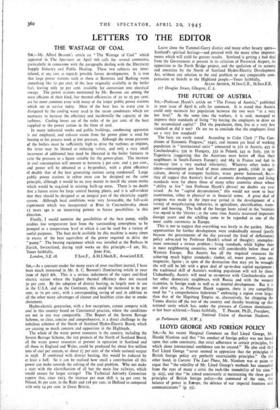THE WASTAGE OF COAL
LETTERS TO
THE EDITOR
SIR,-Mr. Alfred Bosom's article on " The Wastage of Coal " which appeared in The Spectator on April 6th calls for several comments,
particularly in connexion with the paragraphs dealing with the Electricity Supply Industry and Public Heating. These two subjects are inter- related, at any tate as regards possible future developments. It is true that large power stations such as those at Battersea and Barking waste something like 7o per cent. of the heat originally available in the boiler fuel, leaving only 3o per cent. available for conversion into electrical energy. The power stations mentioned by Mr. Bossom are among the most efficient of their kind, but thermal efficiencies of 20 to 25 per cent. are far- more common even with many of the larger public power stations which are in service today. Most of the heat loss in every case is dissipated by the cooling water used in the steam condensers which are necessary to increase the efficiency and incidentally the capacity of the turbines. Cooling losses are of the order of 6o per cent. of the heat supplied to the power station in the form of coal.
In many industrial works and public buildings, condensing apparatus is not employed, and exhaust steam from'the power plant is used for heating or for process work at low pressure. Although the steam pressure of the boilers must be sufficiently high to drive the turbines or engines, the latter may be likened to reducing valves, and only a very small increment of additional heat need be liberated in the boiler furnaces to raise the pressure to a figure suitable for the power-plant. The increase in coal consumption will amount to between 3 per cent, and 5 per-cent., and power will be obtained as a by-product, with a plant efficiency of double that of the best generating stations using condensers". Large public power stations in urban areas can be designed on the same principle, although it would be no easy matter to install the steam mains which would be rewired in existing built-up areas. There is no doubt that a future exists for large central heating plants, and it is self-evident that they should be designed as an integral part of the electricity supply system. Although local conditions were very favourable, the full-scale experiment which was inaugurated at Brno in Czechoslovakia about 55 years ago is an interesting pointer to future possibilities in this direction.
Finally, I would mention the possibilities of the heat pump, whith enables low temperature heat from the surrounding atmosphere to be pumped to a temperature level at which it can be used for a variety of useful purposes. The heat male available by .this machine is many times in excess of the heat equivalent of the power required to drive the " pump." The heating equipment which was installed at the Rathaus in Zurich, Switzerland, during 1938 works on this principle.—I am, Sir, London, S.E. 18. F.Inst.F., A.M.I.Mech.E., AssociateI.E.E.


























 Previous page
Previous page